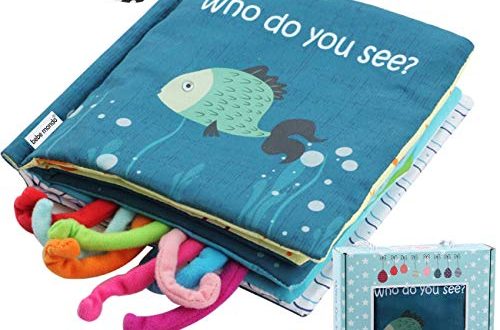
Your baby’s wake windows by age– Nested Bean
You might know how many naps your baby needs in a day, but do you know how long they should stay awake in between? If your little one is struggling to snooze when you put them to sleep, you may want to reconsider their wake windows.
Wake windows are when you truly get to know your baby: their likes and dislikes, their favorite foods and games, and the little quirks that make them unique! However, to make the most of these wake windows, you need to make sure that they’re at the right length and frequency.
After all, an overtired baby will struggle to stay awake, and too little awake time can make them cranky at night!
Here we’ll help you figure out the best wake windows for your family, going through different ages, and how your baby’s wake window will change as they grow.
What are baby wake windows?
A wake window is exactly what it sounds like – a period of time when your baby is awake! This includes almost all of the activities you do with your baby, from feeding and playing to getting them ready for bed.
Though parents are likely to have an idea of their little one’s nap schedule and sleep periods, their wake windows tend to be less considered, even though they also have an important effect on your baby’s sleep. For example, if your baby hasn’t had a long enough wake window, they might struggle to fall asleep when it’s nap time or bedtime.
As you’ve probably worked out, wake windows work in tandem with periods of sleep – your baby is either in one or the other! But even if you’ve planned out your naps, you may still want to take your little one’s wake windows into consideration.
Baby expert Cara Dumaplin from Taking Cara Babies has a great explanation of the importance of wake windows:
‘Why are wake windows important? Well, wake windows that are too long can result in an overtired baby or toddler who struggles to calm down enough to fall asleep or stay asleep.
On the other hand, wake windows that are too short can result in a baby or toddler who simply isn’t ready to fall asleep or will only take a tiny catnap.
If you get wake windows just right, you’re setting your baby or toddler up to be able to fall asleep more easily and stay asleep longer.’
Wake windows by age
Wake windows can have a big impact on the amount and quality of your little one’s sleep – that’s why we’ve created a chart detailing age-appropriate wake windows all the way up to 24 months!
Don’t worry if your child likes to stay awake for a little more or less time than what we’ve described here – every baby is unique, and these timings are just a guide to help you plan your baby’s wake windows in a way that best suits your family.
0-3 month wake windows –> up to 90 minutes
Newborn 45 to 60 min
1 -2 months 1 to 2 Hours
2-3 months 75 mins to 2 Hours
Generally speaking, a newborn wake window for your baby will only be up to around 90 minutes maximum, with lots of shorter naps in between. As your baby (hopefully!) sleeps for most of the day – some newborns even snooze for up to 19 or 20 hours a day – their wake windows tend to be short to accommodate these rest periods.
If your baby is sleeping for significantly less time than this, they’re likely to be very overtired; this might be contributing to a vicious cycle where your baby is actually too tired to sleep! That’s why short wake windows are vital at this point in their life.
If you find yourself stuck in this loop, swaddling could be the solution – and we think our Zen Neo is the perfect first swaddle for any baby. Made with snug and stretchy fabric and designed with a womb-like shape, the Zen Neo eases the womb-to-world transition and mimics your soothing touch to help your little one fall asleep.
If you find that you’re struggling to stretch your baby’s wake windows further, baby sleep consultant Amy Motroni has some advice:
‘Some babies will start to show sleepy cues early on in their wake window and you may think they need a nap long before they actually do. This is what happened frequently with my daughter.
Around 11-weeks old, she would yawn at the 60-minute-mark, but from trial and error, I knew she needed a little extra time in order to take a long and restorative nap.
The best analogy I can give for this is this. If your toddler is hungry at 4:30 pm but dinner will be ready at 5:00 pm. You don’t want to give your toddler a snack now because then they won’t eat dinner.
Instead, you want to make sure they are hungry enough to sit and eat dinner with the family.
Baby’s wake windows for sleep are similar.’
3-6 month wake windows –> up to 3 hours
3-4 months 1.5 to 2 hours
4-5 months 2 to 2.5 hours
5-6 months 2 to 3 hours
Once your baby has reached three months, they’ll be more alert and able to stay awake for longer periods of time between naps. This means that each wake window can be extended to be roughly two hours, and up to three hours once they’re at the older and of this age range.
Even with each wake window perfectly planned, you might find that your baby is finding it difficult to fall asleep – especially if you’re starting to transition them away from swaddling.
Our adaptable Zen One can be used even past this stage, with removable mesh sleeves that allow you to easily transform yours from a swaddle to a sleep sack! Not only that, but like all our Zen Sleepwear, it features strategically placed Cuddle Pads to mimic your soothing touch. Here’s what Zen Mom Kali K. has to say about hers:
‘Our little guy was wiggling out of every swaddle and not sleeping well at night. Got up several times, etc. We had a friend who tried this for their baby and loved it.
It’s truly worked so well from night one—he’s just 3 months and gets up once in the night now.
Also he barely cries when I actually put him in it…I think he feels cozy. It’s also awesome that it can transition to arms out when he’s ready!’
6-9 month wake windows –> Up to 4 hours
6-7 months 2.5 to 3 hours
7-8 months 3 to 4 hours
8-9 months at least 4 hours
After your baby is over half a year old – time really does fly by with a baby! – you can extend the length of each wake window even further. From here on, your baby should be able to stay awake for around three hours at a time, with only two or three naps in between.
At this stage, you might find that your little one is hitting a sleep regression that’s interrupting their planned naps and wake windows – in that case, you might want to try our Zen Sack! A cozy wearable blanket with gentle weight to soothe even the fussiest baby, this is perfect for maintaining your schedule and ensuring your little one gets the quality sleep they need.
Here’s what blogger Lachelle from Full Heart Mommy has to say about our Zen Sack:
‘It’s a gently weighted sleep sack with a weighted center to mimic your touch. Sleep sacks are essential for young babies because you don’t want them laying on loose sheets or bedding to reduce the risks of suffocation. A sleep sack is essentially a wearable blanket!
The Zen Sleep sack also has a two way zipper and two adjustable shoulder tabs. Perfect for my baby who is taller than average. Diaper changes are easy to do in this sleep sack.
The material is great, high quality. The cotton is great for all seasons, I don’t feel like my baby overheats in this sleep sack.
I’ve washed this sack multiple times per week and it does not pill or get rough. In addition, the sack still feels as soft and comfy as day one.’
9-12 month wake windows –> up to 5 hours
9-10 months at least 4 hours
10-11 months 4 to 5 hours
11-12 months 4 to 5 hours
Between nine months and twelve months, your little one should be staying awake between naps for at least three hours and up to four hours once they’re approaching a year old.
12-18 month wake windows –> Up to 6 hours
12-18 months 5 to 6 hours
Once your little one is past the year mark and transitioning into toddlerhood, they’ll be able to go for much longer without having a nap or going to bed. With any luck, they’ll be sleeping through the night at this point too – without early morning wake ups!
At this age, they’ll be able to go for around five hours in between periods of sleep, which means they’ll be able to take part in much more family activities without interruptions!
18 months and beyond
At this point, your toddler is likely to only be having one nap per day, meaning that you won’t need to be considering their wake windows to the same extent – after all, they’ll be awake for most of the day at this point, and having a much longer stretch of night sleep than they did at a few months old.
However, it’s still important to consider the timing of your child’s nap and how it effects their sleep – too early and they may not want to snooze, too late and they won’t sleep at bedtime!
Commonly asked questions about baby wake windows
Why is the first wake window the shortest?
The first few wake windows of your baby’s life will be very short, less than an hour and a half, and will continue to be throughout the newborn phase until they’ve reached around 12 weeks of age.
This is because your baby needs plenty of sleep to aid their growth at this stage – a surprising amount of brain development actually happens when your little one is catching some Zs!
When do wake windows not matter?
Wake windows are most important when your baby is having multiple naps per day, as you need to ensure that your little one isn’t too overtired or too energetic to sleep.
This becomes less important once your baby is only having one nap per day, as their wake window before their nap and their bedtime will be significantly longer.
How many wake windows should a newborn have?
Newborn sleep varies from baby to baby, and can range from 12 to 20 hours a night – both ends of this spectrum are totally normal!
Because they’re spending most of their day asleep, split between lots of short naps, their wake windows tend to be very short, ranging from 45 minutes up to 90 minutes maximum, and it isn’t usually long until the next wake window!
You’ll want to make sure that a wake window doesn’t go too far beyond this, as it can lead to overtiredness, which actually makes it harder for your baby to sleep!
Do wake windows include feeding?
Absolutely! Wake windows actually include almost all of the activities your baby takes part in, including playing, changing, tummy time, and feeding.
The only time that feeding isn’t included is if you’re choosing to do dream feeds through the night – these are feeds where you don’t fully wake up your baby, letting them stay drowsy so they fall back asleep again right after they’re done eating.
When to extend wake windows?
As a rule of thumb, you’ll want to extend your baby’s wake windows as they age and start taking fewer naps throughout the day.
Keep in mind that this is a gradual process. You want to ease your baby into a sleep schedule that will serve as a foundation for healthy sleep through their childhood, and this takes time!
Don’t be too concerned if your baby is drifting off to sleep in the middle of a wake window; they’re to likely just need a little more time to adjust, and that’s totally normal.
You may also like
How do parents around the world handle bedtime?
When do toddlers stop napping?
How to end all-nighters
April 17, 2023
Athena S.




